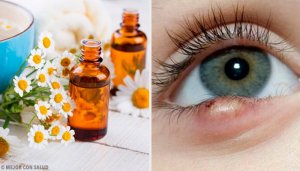5 Easy Tricks for Treating Styes


Written and verified by the doctor Grecia Morillo

Possible causes of styes
The most common causes of styes are:
Staph infections
Nine out of ten styes are caused by staph infections. Staphylococci bacteria live on the skin and nose and are not harmful under normal conditions. However, if they come in contact with the rim of your eyelid, they can cause infection.
Touching your eyes with dirty hands, changing your contacts without disinfecting them first, or leaving eye makeup on all night can cause staph infections.
Chronic eyelid inflammation
Also known as chronic blepharitis, this inflammation usually affects both eyelids and can cause irritation and redness.
Read more: 5 Home Remedies To Relieve Swollen Eyelids
Stye symptoms
The signs and symptoms of a stye are:
- A red bump on your eyelid, similar to a pimple or whitehead
- Pain in your eyelid
- Swelling of the eyelids
- Water eyes
- Rheumy eyes
- Sensitivity to light
- Feeling like you have something in your eye
Tricks for treating styes
Have you ever had a stye? If you have, or if you get them often, keep reading. Here are some home remedies for treating styes.

1. Gold
If you’re trying to treat a stye quickly, one of the most ancient methods, which actually works the pretty good, is applying heat to the affected area. People usually use gold jewelry for this.
Method
- Rub a ring, or any piece of gold against a clean cloth or piece of clothing.
- Keep rubbing until the ring is warm.
- Place it directly on the stye.
- Repeat 10 times in a row every day.
*According to scientists, the relief from this method comes from the heat, not the fact that the object is made of gold.
Please read: 9 Medicinal Benefits of Aloe Vera Gel
2. Topical aloe vera
Aloe vera gel is a popular remedy for styes because of its soothing, hydrating, and healing properties.
You need a spear of aloe vera and a piece of gauze. Peel the aloe vera and rinse the peeled piece with water. Then, use the gauze to apply it to your eyelid.
*This method has not been scientifically proven. Nevertheless, it continues to be a very popular folk remedy, as several medicinal properties are attributed to the plant.
3. Chamomile tea bags
Chamomile has anti-inflammatory and soothing properties and can help relieve the symptoms of a stye.
Prepare one chamomile tea bag in a cup of boiling water. Let it steep for five minutes, and then place the teabag on your stye. Leave it there for ten minutes, and repeat twice a day.
4. Chamomile essential oil
Just as there are those who resort to chamomile infusion to relieve inflammation and itching, there are those who apply a few drops of essential oil of this same herb, as it has similar effects.
In fact, studies on rodents have shown that chamomile essential oil has an anti-inflammatory effect.
5. Cucumber slices
According to beliefs, placing a slice of fresh cucumber (previously soaked in water) on the stye for a while helps relieve itching and inflammation. This is because cucumber is attributed with soothing and anti-inflammatory properties.
Read more: Do You Know the Best Natural Antibiotics?
Other tips
It’s not a good idea to constantly touch the stye with your hands (much less without having previously washed your hands with soap and water), nor should you try to ‘pop’ or ‘drain’ it with sharp objects or your fingernails, as this can only worsen the problem.
Instead, you can resort to washing the area with soap and water, the remedies mentioned above and the following tricks that we will discuss below.
Antibiotic creams
Antibiotic ointments can help a stye when the cause is a staph infection. A doctor will prescribe the medication, just follow the instructions they give you during the appointment.
Keep your glasses and contact lenses clean
If you use contact lenses, try not to use them until your stye is gone. They could be contaminated with the bacteria that caused your stye. Make sure they are clean and wash your hands well before touching them.
We also recommend you wash everything that might have come into contact with your eye, such as pillowcases, sheets, cushions, towels, etc.
All cited sources were thoroughly reviewed by our team to ensure their quality, reliability, currency, and validity. The bibliography of this article was considered reliable and of academic or scientific accuracy.
- Willmann D, Guier CP, Patel BC, et al. Stye. [Updated 2022 Aug 8]. In: StatPearls [Internet]. Treasure Island (FL): StatPearls Publishing; 2022 Jan-. Available from: https://www.ncbi.nlm.nih.gov/books/NBK459349/
- InformedHealth.org [Internet]. Cologne, Germany: Institute for Quality and Efficiency in Health Care (IQWiG); 2006-. Styes and chalazia (inflammation of the eyelid): Overview. 2019 Dec 5. Available from: https://www.ncbi.nlm.nih.gov/books/NBK557372/
- Bialer MG, Baron EJ, Harper RG. Erythromycin bioactivity is stable in ophthalmic ointment used for prophylaxis of neonatal gonococcal conjunctivitis. Antimicrob Agents Chemother. 1987 Jun;31(6):954-5. doi: 10.1128/AAC.31.6.954. PMID: 3619431; PMCID: PMC284221.
- Bragg KJ, Le PH, Le JK. Hordeolum. [Updated 2022 Aug 14]. In: StatPearls [Internet]. Treasure Island (FL): StatPearls Publishing; 2022 Jan-. Available from: https://www.ncbi.nlm.nih.gov/books/NBK441985/
- Lindsley K, Nichols JJ, Dickersin K. Interventions for acute internal hordeolum. Cochrane Database Syst Rev. 2013 Apr 30;4(4):CD007742. doi: 10.1002/14651858.CD007742.pub3. Update in: Cochrane Database Syst Rev. 2017 Jan 09;1:CD007742. PMID: 23633345; PMCID: PMC4261920.
- Stye. (2021). Cleveland Clinic. Available in https://my.clevelandclinic.org/health/diseases/17658-stye
- Nejabat M, Reza SA, Zadmehr M, Yasemi M, Sobhani Z. Efficacy of Green Tea Extract for Treatment of Dry Eye and Meibomian Gland Dysfunction; A Double-blind Randomized Controlled Clinical Trial Study. J Clin Diagn Res. 2017 Feb;11(2):NC05-NC08. doi: 10.7860/JCDR/2017/23336.9426. Epub 2017 Feb 1. PMID: 28384900; PMCID: PMC5376801.
- Woźniak A, Paduch R. Aloe vera extract activity on human corneal cells. Pharm Biol. 2012 Feb;50(2):147-54. doi: 10.3109/13880209.2011.579980. PMID: 22338121.
- Radomska-Leśniewska DM, Osiecka-Iwan A, Hyc A, Góźdź A, Dąbrowska AM, Skopiński P. Therapeutic potential of curcumin in eye diseases. Cent Eur J Immunol. 2019;44(2):181-189. doi: 10.5114/ceji.2019.87070. Epub 2019 Jul 30. PMID: 31530988; PMCID: PMC6745545.
- Dua, A., Garg, G.K., Kumar, D., & Mahajan, R. (2014). POLYPHENOLIC COMPOSITION AND ANTIMICROBIAL POTENTIAL OF METHANOLIC CORIANDER (CORIANDRUM SATIVUM) SEED EXTRACT.
This text is provided for informational purposes only and does not replace consultation with a professional. If in doubt, consult your specialist.








